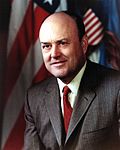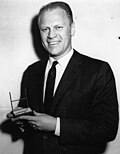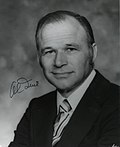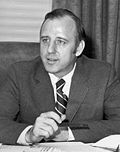Young Turks (U.S. politics)
 From Wikipedia - Reading time: 8 min
From Wikipedia - Reading time: 8 min
The Young Turks was a splinter group of politicians in the United States within the Republican Party during the early 1960s. The group, mostly consisting of congressmen who had become disenchanted with the course of the Republican Party, worked within the system to appoint their fellow members into leadership roles, so they could take control of the party.[1] They were considered "rebels" by the traditional Republicans.[1][2] Gerald Ford, who would become president of the United States, rose to prominence as a Young Turk.
Etymology
[edit]There has been no special meaning given or discussed for the group's choice of the name "Young Turks" in any of the biographical collections of the members. The dictionary definition states, "an insurgent or a member of an insurgent group especially in a political party...one advocating changes within a usually established group".[3] On the other hand, the term Young Turks originally referred to a group of intellectuals during the 19th century Ottoman Empire, who were in opposition to Sultan Abdul Hamid II.
Formation
[edit]The group began in the early 1960s as a loose network of younger Republican congressmen.[4] According to an article that appeared in New York Magazine in 1975, Charles E. Goodell of New York and Robert P. Griffin of Michigan got together in January 1963 and came up with a plan to supplant one of the elder statesmen, Charles Hoeven, who was Chairman of the House Republican Conference. They solicited Gerald Ford of Michigan as the challenger. Ford agreed and won the ballot, becoming the new Chairman.[2]
It was Lyndon B. Johnson's landslide defeat of Barry Goldwater in the 1964 presidential election, coupled with heavy losses in the House, that mobilized all the key players to further action. The Young Turks questioned the Republican Party's viability[4] and wanted to change the direction of the party.[5][6] Donald Rumsfeld, another member of the group, later wrote about how dire it was, "Republicans in the U.S. House of Representatives were reduced to a low of 140 of the 435 Members of Congress. There were so many Democrats that some had to sit in the Republican side of the [a]isle."[7]
The Young Turks decided it was time to take control and replace the top Republican leadership in Congress. They picked Gerald Ford over their other option, Melvin Laird (Wisconsin), to oust the presiding House Minority Leader, Charles Halleck.[5] Their choice of Ford, and his subsequent win, set the stage for Ford to later be tapped as vice-president, and then president by succession.[citation needed]
Members
[edit]According to New York, members included:[2]
References
[edit]- ^ a b Rumsfeld, Donald (2012). Known and Unknown: A Memoir. Sentinel Trade. p. 91. ISBN 978-1595230843.
- ^ a b c Reeves, Richard (October 13, 1975). "Why American Politicians Are So Bad: The Case History of Gerald Ford". New York Magazine: 35.
- ^ Merriam-Webster Dictionary.
- ^ a b Siracusa Ph.D., Joseph M. (2012). Encyclopedia of the Kennedys: The People and Events That Shaped America. ABC-CLIO. ISBN 978-1598845389.
- ^ a b Friedersdorf, Max (30 January 2009). "Gerald R. Ford Oral History Project, interview by Richard Norton Smith". Gerald R. Ford Presidential Foundation. Retrieved 3 September 2021.
Smith: What was the beef against Halleck? Friedersdorf: It's a combination of the age thing and minority status, and Halleck had a drinking problem. That was pretty well known. And then you had a group of Young Turks like Gerald R. Ford and Melvin Laird and Donald Rumsfeld and Bob Griffin, and they were up and coming. It was a generational difference and it was after the '64 election which was such a debacle. We lost a lot of seats in the Goldwater election. The house members felt it was time for Charlie to go.
- ^ Peabody, Robert L. "Professor of Political Science". ROBERT L. PEABODY RESEARCH INTERVIEW NOTES, 1964-67. Gerald R. Ford Presidential Library & Museum. Retrieved 26 March 2013.
- ^ Rumsfeld, Donald. "The Ford-Halleck Race 1964-1965" (PDF). Rumsfeld Personal Library. Retrieved March 23, 2013.
 KSF
KSF











